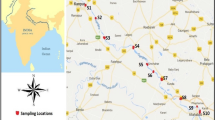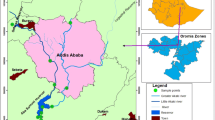Abstract
Sewage contaminated with toxic metals is being naturally treated in ponds at East Kolkata Wetlands (EKW) for fish cultivation traditionally. From the aquatic phase, these metals get settled on sediment and undergo partitioning. Some fractions are available and may accumulate in the cultivated products. The present study highlights the degree of partition of heavy metals Lead (Pb), Cadmium (Cd) and Chromium (Cr) in these pond sediments. The study reveals that Pb and Cr are significant (39% and 30%, respectively) in Fe-Mn bound fractions. Residual fraction is in the order of Pb > Cr > Cd. The easily available fraction of metals recorded higher in Cd (43.0%) and Cr (42.0%).The risk assessment code (RAC) analysis records that these metals could be considered as potential risk group of metals for higher mobility and availability in these pond ecosystems and is a significant concern for aquaculture products.


Similar content being viewed by others
References
American Public Health Association (2017) Standard Methods for the Examination of Water and Wastewater, 23rd Edition, Baltimore, Maryland
BIS (1991) Specifications for Surface Water Discharge (IS-2296). Bureau of Indian Standards, New Delhi
Dasgupta A, Sarkar S,Ghosh PB, Saha T, Sil AK (2016) Phosphorous Dynamics of Aquatic System constitute an important axis for Wastewater purification in natural treatment ponds in East Kolkata Wetlands. Ecol Eng 90:63–67
Dutta J, RoyChoudhury G, Mitra A (2017) Bioaccumulation of Toxic Heavy Metals in the Edible Fishes of Eastern Kolkata Wetlands (EKW), the Designated Ramsar Site of West Bengal, India. Int J Aquac Fish Sci 3(1):018–021. DOI: https://doi.org/10.17352/2455-8400.000023
Dutta J, Zaman S, Thakur TK, Kaushik S, Mitra A, Singh P, Kumar R, Kee Zuan AT, Samdani MS, Alharbi AS, Datta R (2021) Assessment of the bioaccumulation pattern of Pb, Cd, Cr and Hg in edible fishes of East kolkata Wetlands, India. Saudi J Biol Sci. https://doi.org/10.1016/j.sjbs.2021.09.0391319-562X
Förstner U, Wittmann GTW (1981) Metal pollution in the aquatic environment, 2nd edn. Springer, Berlin
Ghosh D (1984) Significance of wetlands in environmental rescue: Lessons from Calcutta’s waste recycling backyards. East Calcutta Wetland Project Report. Department of Fisheries, Government of West Bengal
Ghosh PB, Saha T, Bandyopadhyay TS (2000) Distribution of lead, cadmium and chromium in the waste water of Calcutta canals. Res J Chem Environ 4(3):33–33
Ghosh PB, Mandal S (2019) Degree of partitioning of heavy metals in different environmental segments of a sewage-fed fishery pond at East Kolkata Wetland, India – A case study. IJCAES 1(1):7–14
Godfred D, David A, Nelson KL (2016) Accumulation of toxic metals in fish raised fromsewagefed aquaculture and estimated health risk associated with their consumption. Cogent Environ Sci 2:1190116
Hakanson L (1992) Sediment variability. In: Burton GA Jr (ed) Sediment toxicity assessment. Lewis Publishers, Boca Raton, pp p19-36
Jackson ML (1967) Soil chemical analysis. Prentice Hall of India Private Limited, New Delhi, p 583
Jain CK (2004) Metal fractionation study on bed sediments of River Yamuna, India. Water Res 38:569–578
Khan WR, Zulkifli SZ, Kasim MRM, Zimmer M, Pazi AM, Kamrudin NA, Rasheed F, Zafar Z, Mostapa R, Nazre M (2020) Risk assessment of heavy metal concentrations in sediments of matang mangrove forest reserve. Trop Conserv Sci. 13(1). https://doi.org/10.1177/1940082920933122
Klink A, Dambiec M, Polechońska L (2019) Trace metal speciation in sediments and bio-accumulation in Phragmitesaustralisas tools in environmental pollution monitoring. Int J Environ Sci Technol 16:7611–7622
Kumar B, Shah R, Mukherjee DP (2011) Geo-chemical distribution of heavy metals in sediments from sewage fed fish ponds from Kolkata Wetland, India. Chem Spec Bioavailab 23(1):24–32
Matabane DL, Godeto TW, Mampa RM, Ambushe AA (2021) Sequential extraction and risk assessment of potentially toxic elements in river sediments. Minerals 11:874. https://doi.org/10.3390/min11080874
Maiti P, Banerjee S (2012) Fate of metals in fish under variable sewage input in fish ponds. Int J Sci Res Publ 2:1–13
Modak DP, Singh KP, Chandra H, Ray PK (1992) Mobile and bound forms of trace metals in sediments of the lower Ganges. Water Res 26(11):1541–1548
Raychaudhuri S, Salodkar S, Sudarshan M, Thakur AR (2007) Integrated resources recovery at East Calcutta Wetland: how safe is this? Am J Agric Biol Sci 2:75–80
Roy PK, Roymazumdar MB, Mazumdar A (2014) Role of sewage fed fisheries for treatment of dry weather flow of Kolkata city maintaining the eco-toxicity balance. J Chem Pharm Res 6(9):328–333
Sanyal P, Chakraborty SK, Ghosh PB (2015) Phytoremedation of sewage-fed wetlands of east Kolkata, India—a case studies. Int Res J Environ Sci 4(1):80–89
Sarkar S, Ghosh PB, Sil A, K,Saha T (2014) Suspended Particulate Dynamics acts as a driving force for single pond sewage stabilization system. Ecol Eng 69:206–212
Saha T, Ghosh PB (2003) Wise use of wetland in water conservation and advance irrigation methods—a case study. In: Technical volume of the National Seminar on role of agricultural engineers in water conservation, pp 74–78
Sarkar S,Ghosh PB, Sil AK, Saha T (2010) Heavy metal pollution assessment through comparison of different indices in Sewage-fed Fishery pond sediments at East Kolkata Wetlnd, India. Environ EarthSci 63(5):915–924
Sarkar S, Ghosh PB, Mukherjee K, Sil,Saha T (2009) Sewage treatment in a single pond system at East Kolkata Wetland, India. Water Sci Technol 60:2309–2317
Salomons W, Forstner V (1984) Metals in hydrocyle 2. Springer, Berlin, p 349
Sundaray SK, Nayak BB, Lin S, Bhatta D (2011) Geochemical speciation and risk assessment of heavy metals in the river estuarine sediments—a case study: Mahanadi basin, India. J Hazard Mater 186:1837–1846
Sengupta S, Chatterjee T, Ghosh PB, Saha T (2010) Heavy metal accumulation in agricultural soils around a coal fired Thermal Power Plant (Farraka) in India. J Environ Sci Eng 54(4):299–306
Tessier A, Campbell P, Bisson M (1979) Sequential extraction procedure for the speciation of particulate trace metals. Anal Chem 51:844–851
Acknowledgements
We are grateful to the director of this Institute for the opportunity, encouragement and laboratory facilities rendered to us to continue the study.
Author information
Authors and Affiliations
Corresponding author
Ethics declarations
Conflict of interest
No conflicts of interest have been declared.
Additional information
Publisher’s Note
Springer Nature remains neutral with regard to jurisdictional claims in published maps and institutional affiliations.
Rights and permissions
About this article
Cite this article
Mukherjee, P., Das, P.K. & Ghosh, P. The Extent of Heavy Metal Pollution by Chemical Partitioning and Risk Assessment Code of Sediments of Sewage-Fed Fishery Ponds at East Kolkata Wetland, a Ramsar Site, India. Bull Environ Contam Toxicol 108, 731–736 (2022). https://doi.org/10.1007/s00128-021-03447-6
Received:
Accepted:
Published:
Issue Date:
DOI: https://doi.org/10.1007/s00128-021-03447-6




